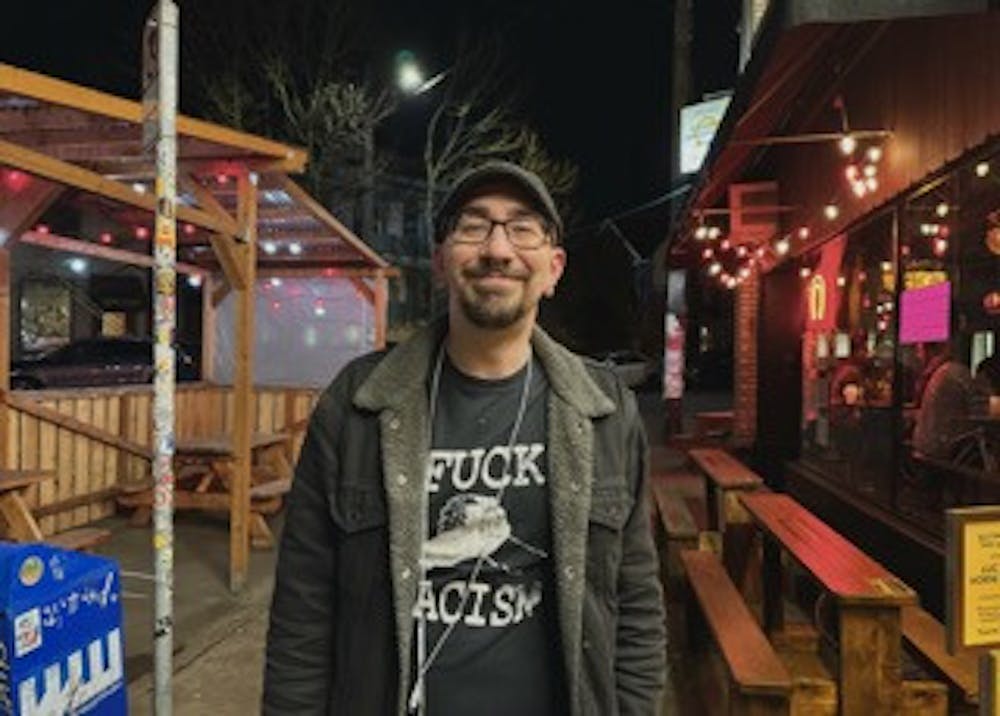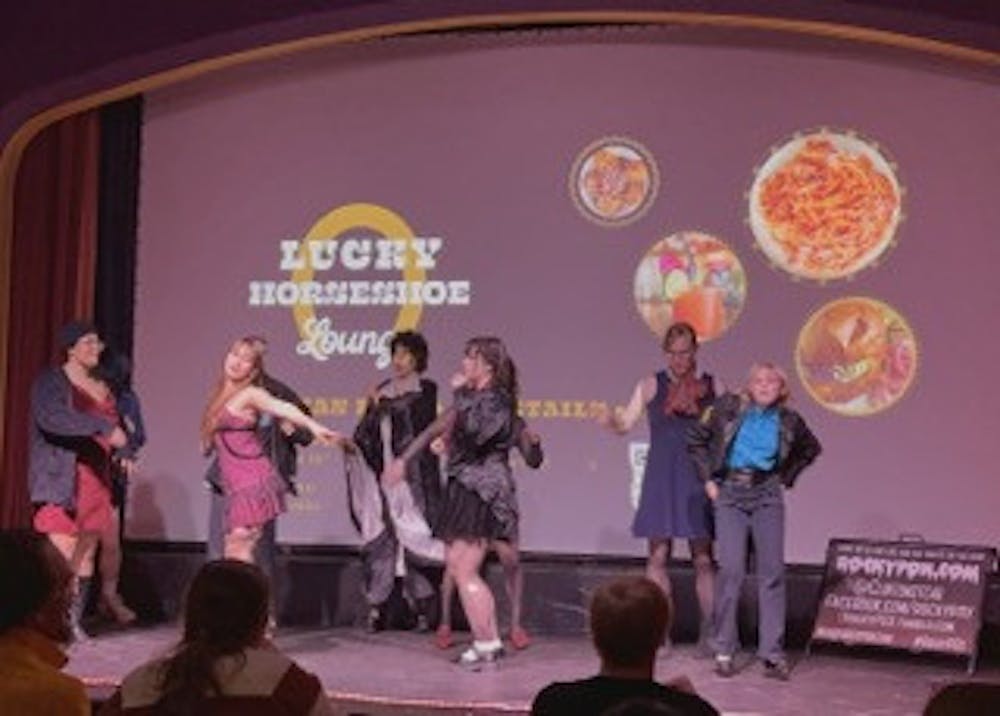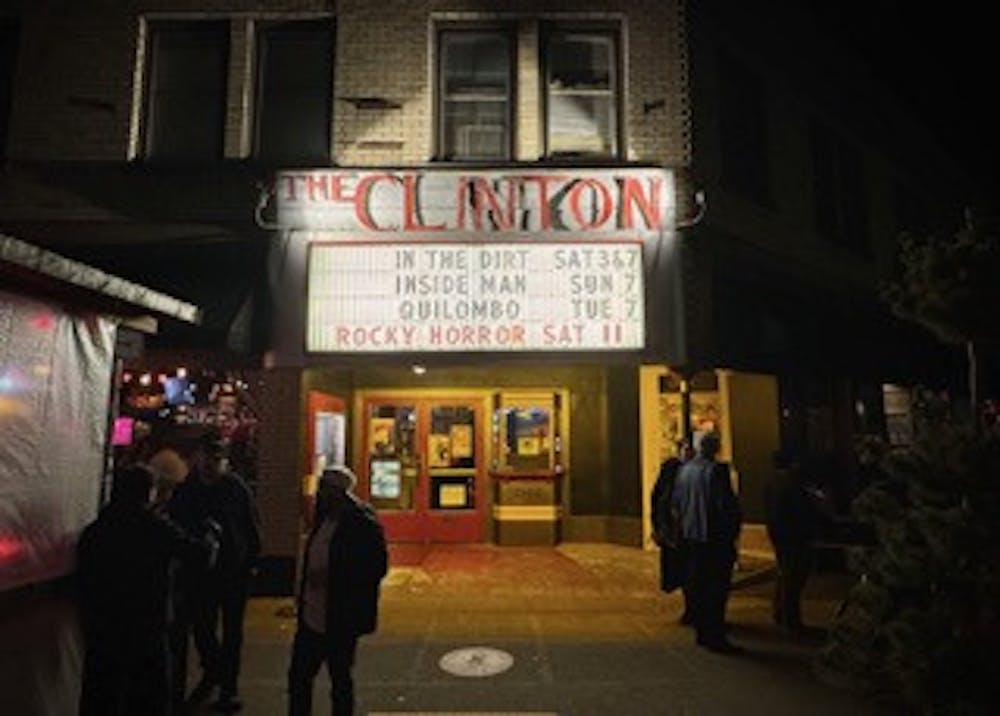I had never been more excited to be a virgin. The stage I stood on was crowded with other eager newcomers in fishnet tights and racoon-eye makeup. We had all been plucked from the audience and put under a spotlight at “The Rocky Horror Picture Show.”
I was made to chug water in front of a crowd of nearly forty people.
The Clinton Street Cabaret begins their bimonthly productions of “Rocky Horror” with the “virgin games.” During these games, “Rocky Horror” novices (more affectionately called "virgins") played rounds of suggestive chubby-bunny and kama sutra charades. Nobody went home with a gold medal in Rocky-Horror chastity, but we all went back to our seats feeling as though something had changed. We had finally been initiated into the world of “Rocky Horror.”
“Rocky Horror” debuted at the Clinton Street Theater in 1978, alongside the birth of the Cabbage Patch Doll and Reese’s Pieces. But unlike cabbage toys and the most amazing candy ever, “Rocky Horror'' has remained a fixture within LGBTQ+ communities everywhere.
“Rocky Horror’s” inclusivity stood out to Kyle Horton, a cabaret actor, when he first saw the film.

“Watching the movie, I was not old enough to comprehend what was going on,” Horton said. “I was like ‘OK, the dude’s in heels. Alright. Soundtrack’s awesome. That’s cool.’”
“Rocky Horror” can indeed be summed up in three words: “Soundtrack is awesome.” But, the film-musical also follows the journey of straight-laced couple Brad Majors and Janet Weiss. Stranded in an unfamiliar area, the two seek shelter in a castle inhabited by aliens from the galaxy Transylvania. Chief among them is Frank-N-Furter, a scientist in drag who introduces the couple to his most prized (and most buff) creation, Rocky.
While the movie’s plot is memorable all on its own, the interactive components of a “Rocky Horror” viewing has elevated the film beyond your typical quirky watch. With the help of the Clinton Street Cabaret — a shadow cast which acts out the movie as it is playing — audience members are able to throw rice and shout things which would normally get you a slap upside the head at your everyday theater.
“Especially in the days before the internet, [going to Rocky Horror] was just a fun thing to do,” Aaron Colter, an owner of the theater, said. “It was interactive. It was risqué. That tradition is there for a lot of people who are learning more about themselves and how they want to fit in the world, how they want to push boundaries.”
As I looked out into the audience from the front of the stage, I was surprised to see that not everyone was dressed as though they’d survived a Hot-Topic explosion. Sure, when it came to the section of the seating reserved for the cabaret, that’s where the dyed hair and pierced skin came alive. But just past those whose drag immediately caught my eye were older couples sharing popcorn. Girls nervously texting on their phones. Friends cheering for their loved ones up on stage.
Once I gave the water cup back, a cabaret member released me to my seat. And soon after, the movie began, but not with the typical hush that happens at an AMC once the lights dim.
The callbacks had begun. “Kill that smurf!” “Horse brutality?!” I began hearing some so creative I was convinced everyone was in on some game except for me. The objective wasn’t to make people laugh (how funny is a well-timed burp, really?), but rather to muse upon the comedic genius borne only from watching the same film over and over again.
Even with all the noise and thrown rice in my hair, I still couldn’t decide if the Clinton Street actors were annoyed with us. Like the irritating student I was in high school, all I wanted was to impress the teacher. This time, more than anything, I wanted to become the “perfect” “Rocky Horror” audience member.
“A good audience is a double-edged sword,” Horton said. “If you’re loud and obnoxious, it can make a really good or a really bad [crowd].”
The young couple in front of me rocked violently back and forth in their seats. Screams sounded off disjunctively throughout the single-room theater.
Like I felt the audience oscillate between a “good” and “bad” crowd, the cabaret flowed from enhancing and detracting from the movie on screen.
At times, it seemed like the cabaret was competing for my attention over the film on screen. I couldn’t always tell where to look. Was it at the projection, where Brad and Janet had just arrived at the castle? Or at the Brad and Janet lookalikes slightly off stage? And what about when the pretend Frank chased a Meat Loaf impressionist up and down the aisles, grazing shoulders with audience members?
Soon after, comprehension dawned on me. The spotlight shining from behind the audience made shadows of the cabaret actors’ bodies on the large pale faces of movie-Janet-and-Rocky. It wasn’t until Rocky embraced Janet Weiss both on screen and on the stage that I finally got the beauty of the cabaret.
Even with light tricks, it is impossible for any shadow cast to outdo the visual beauty of the film. I couldn’t get lost in the movie like how I did in a quiet AMC watching “Barbie.” The cabaret actors are right there in front of you, their shadows leaving literal imprints upon the screen. You cannot ignore them.
Though complete cinematic immersion was impossible, the cabaret had managed to ground its audience within an arguably more important world — that of reality.
I was sitting with people in costumes. Everyone had their noisemakers and soon the entire theater was littered with thrown props. At every point, I was reminded of the fact that I was surrounded by people who knew far more than me about everything “Rocky Horror.” Yet I did not feel out of my element. I was also dressed up. I, too, threw my rice.
“In the beginning, you’ll notice Frank is the priest [...] and everyone is normied-up,” Abby Lewis, who has worked at the theater for over ten years, said. “When you let your hair down, that’s when you’re the alien from Transylvania.”
Though many newcomers might have difficulty shedding their normie skin, Horton still finds this hesitancy to be a valid experience.
“[What makes a good audience] is just coming in and being yourself,” Horton said. “It’s not being afraid to let your freak flag fly. If you still are afraid to let that flag fly a little bit, that’s okay. We’ll still love you anyway. We’re here when it's ready to unfold.”
The community found at the Clinton Street Theater is the reason why so many audience members choose to go to the cinema and watch a film they could’ve easily pirated online from the comfort of their own beds.

Lewis describes “Rocky Horror” screenings at the Clinton as welcoming as a “queer church.”
“‘Rocky’ is not just about the movie, it's about the ritual of coming, knowing it's happening every Saturday,” Lewis said. “There’s something comforting and almost meditative when you’re a regular.”
But the audience was not the only place I felt myself start to belong. When Frank finds himself drenched in pool water with his makeup dripping off, he hugs himself in a profound display of insecurity — the first that the film sees from him. On stage, his shadow actor displays the same sweetness. I recognized within that actor a vulnerability I had known all my life. I know what will happen to Frank-N-Furter, and so does everyone else in the room.
The show ended and I stayed behind to let the room clear out. Even then, the room maintained its chatter (were there ghosts at the Clinton? The place is over 100 years old). Inside the theater, it still felt like 10:30 p.m., but when I emerged into the dark outside, I checked my phone and saw it was two in the morning. Later that night, I returned to my dorm and shook out my shoes, where grains of rice fell onto the hardwood floor.
Camille Kuroiwa-Lewis is a reporter for The Beacon. She can be reached at kuroiwal26@up.edu.








